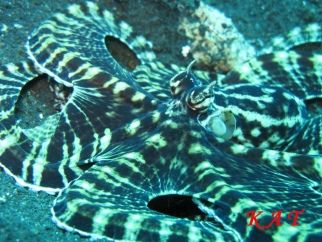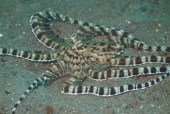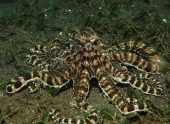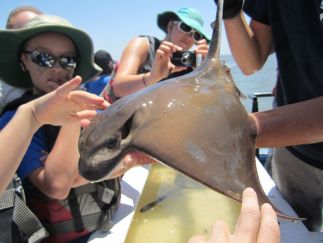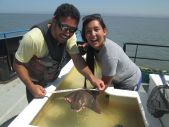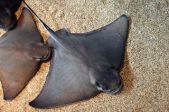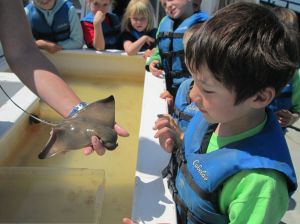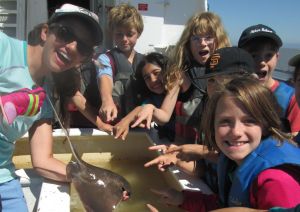#marine science institute
Common Facts:
Scientific name: Gramma loreto
Diet: Small crustaceans, parasitic organisms found on larger fish, plankton
Size: Up to 3 inches
Range: Western Atlantic Ocean—Florida to northern South America and the Caribbean Sea
Despite their tiny size, Fairy basslets are hard to miss. With their bright purple and yellow bodies, it’s easy to spot these darting flashes of color. Fairy basslets are coral reef inhabitants and can generally be found under ledges or in caves.
“Fairy basslets are known to swim upside-down under ledges and along cave ceilings. They live in colonies and defend their territory from other species and even from other fairy basslets. Male fairy basslets guard and care for the eggs and the nest.”
Males find and establish nest sites before they participate in spawning activity. They find small crevices and holes in the reef and line them with algae, to cover the opening. Then, at dawn, female basslets will come to the nesting sites and deposit their eggs in a nest. After 10-11 days, the male’s guard duty is complete and the eggs hatch. “Then the larvae are believed to proceed to the planktonic stage until they are sufficiently heavy to resettle on the reef.”
Something interesting about Fairy basslets is that they are all born female, but can change sex to male. Males are more colorful than females and darken when they are ready to mate. Males also become a little bit larger than the females.
Fairy basslets are a beautiful and fun fish to observe! Take the time to admire them if you ever happen upon them.
Sources:http://www.fishlore.com/Profiles_Fairy_Basslet.htm
http://www.eoearth.org/view/article/152728/
http://www.aqua.org/explore/animals/fairy-basslet
Written by: Kari Shirley, intern
I’m 3 inches long, purple and yellow, and live in coral reefs. Who am I? Common Facts: Scientific name: Gramma loreto Diet: Small crustaceans, parasitic organisms found on larger fish, plankton…It’s not often that you find a fish that would rather walk than swim. Meet the walking fish!
Common Facts: Scientific name -Brachionichthys hirsutus Size - 10-15 cm Diet - Small crustacea and worms…
Common Facts:
Scientific name –Phycodurus eques
Size – Up to 16 inches long
Diet – Krill, mysids, sea lice
Range – South and Western Australia
If you were scuba diving along the rocky reefs of Southern and Western Australia, you might never spot one of the beautiful Leafy sea dragon! For a couple of different reasons. First, these fish are rare. And second, they are camouflaged to blend in perfectly with the seaweeds and seagrass around them!
Leafy sea dragons are related to sea horses, and have a similar body type—except they don’t use their tail to grip things like sea horses do. And they have some extra frills that seahorses do not. “Sea dragons are some of the most ornately camouflaged creatures on the planet. Adorned with gossamer, leaf-shaped appendages over their entire bodies, they are perfectly outfitted to blend in with the seaweed and kelp formations they live amongst.”
Leafy sea dragons have small dorsal and pectoral fins that they use to awkwardly swim through the water. Although a lot of the time, they enjoy just letting the current carry them, like the seaweed they are mimicking.
Something interesting about Leafy sea dragons is that the males are the ones that do the child-bearing! The females deposit their eggs on a brood patch the males have on the underside of their tails. The eggs are fertilized in this process, and then the males carry them for 4-6 weeks until they hatch. Luckily for the parents, the work is then done. Baby sea dragons are independent from birth.
Due to their excellent camouflaging skills, Leafy sea dragons have very few predators, outside of humans. Humans love to catch them and keep them as pets because they are such beautiful creatures. Australia currently has a ban on hunting/fishing/disturbing Leafy sea dragons in the hopes that their numbers will increase.
Sources:
http://www.montereybayaquarium.org/animal-guide/fishes/leafy-sea-dragon
http://animals.nationalgeographic.com/animals/fish/sea-dragon/
Written by: Kari Shirley, intern
Meet the Leafy Sea Dragon–the expert at camouflage! Common Facts: Scientific name -Phycodurus eques Size - Up to 16 inches long Diet - Krill, mysids, sea lice…Common Facts:
Scientific name – Thaumoctopus mimicus
Diet – Small fish and crustaceans
Size – Up to 2 feet long, with 25 centimeter arms
Life span – Said to live for around 9 months
Initially, if you happened upon a Mimic octopus, you would think that it was just a normal, slightly small, octopus. But the Mimic octopus is not your typical octopus. These sea creatures have LOTS of tricks up their sleeve.
It is the behavior of the Mimic octopus that makes it stand out and gives it it’s name. “Mimicry is commonly used as a survival strategy in nature. However the mimic appears to be able to take on the appearance of not just 1 other species, but of several.” Not only that, but all of the other species that the Mimic imitates are venomous, making this a deliberate and evolved tactic of survival.
The Mimic octopus can make itself appear to be a Lion fish, sea snake and a sole/flatfish. It bends and shapes it’s body to look just like theirs. Below is a video showing the Mimic octopus in action.
The Mimic octopus also has a lot of the same physical characteristics of other octopus species have. They have the ability to change the color and texture of their skin to blend into their surroundings to protect themselves. They have “8 arms, a mantle containing 3 hearts and other internal organs, and a siphon used for jet propulsion. The arms have 2 rows of suckers, each sucker having a touch sensor and a chemoreceptor, allowing the mimic effectively to feel and taste its food before it eats it. It has a large brain but lacks the sense of hearing.”
Sources:http://www.dive-the-world.com/creatures-mimic-octopus.php
http://marinebio.org/species.asp?id=260
Written by: Kari Shirley, intern
The Mimic octopus is not your typical octopus. They have LOTS of tricks up their sleeve. Common Facts: Scientific name - Thaumoctopus mimicus Diet - Small fish and crustaceans Size - Up to 2 feet long, with 25 centimeter arms…Scientific Name: Delphinapterus leucas
Size – 13 to 20 feet, 2000 to 3000 pounds
Life span – 35 to 50 years
Diet – Fish, crustaceans, and worms
Beluga whales are born to stand out—with their unusual white color, they are easy to spot and recognize. They aren’t always this color though. Baby Belugas are born gray or brown, and then fade to white as they mature sexually.
Compared to most whales, Belugas are small, ranging from 13-20 feet in length. They are also unique because they lack a dorsal fin, something most fish and marine mammals have. There are several other things that make Belugas special. They have a more complex way of communicating with one another, utilizing clicks, whistles and clangs, along with other sounds that they sometimes mimic.
Beluga whales can be found in the coastal waters of the Arctic Ocean, and in subarctic waters as well. Belugas almost always live and travel in small groups call Pods. They migrate south when the ocean begins to freeze over and have to move quickly, otherwise they could be trapped under the ice and suffocate—or become an easy target for predators, like Polar Bears.
You might wonder why Beluga whales live in such a frigid environment. They have a thick layer of blubber (which can be as thick as 5 inches!) to help keep them insulated and warm. They also have a hard dorsal ridge along their back and a tough forehead, which helps them to swim through the icy sea water.
Beluga whales are truly amazing and beautiful creatures. Should you ever be near arctic waters, take some time and see if you can spot these fantastic white whales! They are worth the wait.
Sources:http://us.whales.org/species-guide/beluga-whale
http://www.defenders.org/beluga-whale/basic-facts
http://animals.nationalgeographic.com/animals/mammals/beluga-whale/
Written by: Kari Shirley, intern
Beluga whales are born to stand out—with their unusual white color, they’re easy to recognize! Scientific Name: Delphinapterus leucas Size - 13 to 20 feet, 2000 to 3000 pounds Life span - 35 to 50 years…Common Facts:
Scientific name – Myliobatis californica
Habitat – Sandy seafloors
Range – Eastern Pacific from Oregon, to the Sea of Cortex and near the Galapagos Islands
Diet – Molluscs, crustaceans, small fish
Size – Female can reach wingspans of 6 feet and weights of 200 pounds, while males are smaller
Life Span – Up to 35 years
The Bat Ray is an animal that we see often at the Marine Science Institute because many of them live here in the San Francsico bay! These graceful creatures get their name from not only the way they look, but they way they swim. They swim by flapping their pectoral fins (which have a strong resemblance to wings). They love to hang out in muddy and sandy bottomed bays, kelp forests and near coral reefs.
Bat Rays use their “wings” for more than just moving around. They flap their fins to stir up the sand on the ocean floor to expose potential food sources. Once they find something to eat, like a clam, they can use their snout to dig them up. Bat Rays have teeth that are fused into plates. This enables them to crush almost any clam shell. They crush the shell, spit out the shards and get the soft and fleshy parts. And lucky for Bat Rays, their teeth are constantly growing! So if a tooth ever breaks, they have nothing to worry about—it will be replaced soon.
Bat Rays tend to be lone riders, except when it’s mating season or time to feed. Female bat rays carry their babies for 9-12 months before giving birth. And they can give birth to 2-12 pups! Depending on how big the mother is.
If you’re ever swimming and see a Bat Ray, it would be better to keep your distance. These creatures have 3 poisonous barbs on their tails that they use to defend themselves from predators. And they won’t stop to ask if you are friend or foe before they use them!
Sources:http://www.montereybayaquarium.org/animal-guide/fishes/bat-ray
http://www.aquariumofpacific.org/onlinelearningcenter/species/bat_ray
Written by: Kari Shirley, intern
It’s smooth! It’s graceful! It’s fierce! It’s the Bat Ray! Common Facts: Scientific name - Myliobatis californica Habitat - Sandy seafloors Range - Eastern Pacific from Oregon, to the Sea of Cortex and near the Galapagos Islands…Summit Public Schools is a high performing charter school organization with seven schools in the Bay Area, including two high schools in Redwood City, Everest and Summit Prep, and two in San Jose, Tahoma and Rainier. Internships are a part of their unique Expeditions program and take place during the school year and school day. They provide an invaluable opportunity for students to get some adult work world experience, explore a possible career, develop confidence and strengthen their communication skills.
During internships students are required to submit journal entries weekly to their advisors. This week I would like to share Danielle’s journal entry.
Journal Question #2: Talk about something new that you have learned at your internship. Describe what you learned, how you learned it, and what it helped you understand or do at your internship. Will you be able to use this new knowledge or skill in the future?
Danielle: While interning at the Marine Science Institute, I have learned a lot about what being a marine scientist might be like, and what goes on behind the scenes of the programs. When I did a trip out on the boat as a data collector, I learned how marine scientists figure out how many of a species are in a given area. When the kids in the class brought in a trawl, I counted and measured the fish, then recorded it in a data base. I also learned more about the life in the bay as I shadowed the classes that happen on shore. I shared the kids enthusiasm toward the marine life and was happy to help the kids learn to identify the different types of fish and invertebrates that they brought up. I am learning to identify the fish too, so I love to practice. I also learn about setup and cleanup, which is how to take out and put away the fish, and clean the buckets we put them in.
I also learned what the office work looks like. The first intern session I had I spent a lot of my time in the office cutting pamphlets and newsletters, and getting gifts ready to send to volunteers. That taught me more about how a nonprofit is run, and how much they are thankful for their volunteers. I also go the chance to see how the data that is collected in the bay is sorted and cleaned of unusable data.
I find that knowing these skills can be very useful. Right now I am working on a project for my school program that is allowing me to be at MSI as an intern. For the project, I am analyzing data from four years leading up to the El Nino, and comparing it to the last one. I realized that this can be important because the El Nino affects more than the weather.Learning the trends helps us understand more about these phenomenons.
Volunteer and internship opportunities are available year round.
Please visit our webpage at www.sfbaymsi.org to find your next volunteer position!
Marine Science Institute is a tax-exempt 501©(3)not for profitorganization
©2016. All Rights Reserved
When I grow up I want to be 800 pounds, 7 feet long and I friends with a scuba diver!
Common Facts: Scientific Name - Stereolepis gigas Habitat - Kelp forests and deep, rocky reefs Conservation Status - listed internationally as critically endangered and are protected in California…

